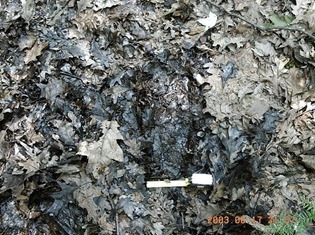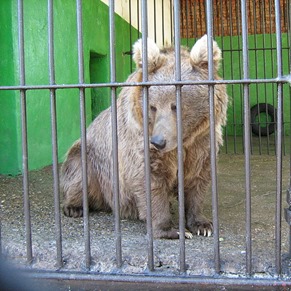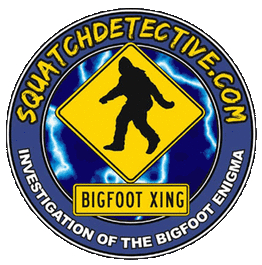Bigfoot research over the decades has had its ups and downs. What I love most are the true scientists that come forward to assist us in the daily fight against pseudo-science and at the same time assist us in the fight against the mainstream science which out of many times, opinion discounts what thousands of witnesses have seen over the generations.
(Left): Track found investigating a sighting report in Whitehall, NY 2003, (Right) Track found along the Poultney River, Vermont. (Photo Credit: Steve Kulls)
One other double standard was the discovery of the Bili Ape. It began to originate from footprint evidence that there was a different type of primate inhabiting the jungles of Africa. However since day one, science has discounted the numerous tracks found by people, citing hoax or misidentification from minute one.
(Left) Print found in Chautauqua County, NY 2016, (Right) Track-way of the Fort Ann Cast 2006) (Photo Credit: Steve Kulls)
Also misleading are some of the statements made by the skeptical scientists interviewed on some documentaries. They generally state opinion. One skeptical scientist actually stated, “If these things were out here, people would be seeing them.”
WHAT????
Squatchdetective Field Investigation Team camp shot 2013
The sad fact is though with the proliferation of social media, it has become easy for false news stories and junk science to be promoted as fact. And it allows people whom naively follow people without doing their homework.
We have seen this time and time again with some of the folks exposed in the Hall of Shame. They obtain a following and what they say is gospel to the people who blindly accept what they preach. That is usually until they do their own research.
I’ve always said here, “Don’t take my word for it. Do your own research and use what I say as a starting point.”
Deflating the Claims of the Ketchum Study
One such scientist that’s on our side, being that he is looking at things from an unbiased point of view is Dr. Haskell V. Hart, who breaks down the nitty-gritty of DNA results and puts them to the test. Particularly Dr. Melba Ketchum’s DNA Study.
The first thing that threw my BS Meter abuzz was the manner in which she released the information.
Many forget about a press release a day or two before the release of the study. This violated the normal standard for scientific studies being released into the public. Dr. Ketchum was charging $30 for a download of the report the next day. Sounded to me like it was a promotional pitch to increase sales, much the way Apple releases their products.
Now one might say she was trying to recoup what she spent in the study, however she was charging the folks that submitted samples in the study for those costs. Not to mention a draconian non-disclosure agreement. Basically stating they had a right to get the results, but couldn’t talk about it, ever, at all unless Dr. Ketchum herself, gives permission.
All of this sounds highly irregular right? But it goes on.
Ketchum had published the study in a scientific journal called the Denovo Journal, which at the time of release was called the Journal of Advanced Multidisciplinary Exploration in Zoology.
Shortly thereafter, as all skeptical Bigfoot researchers do, dug up the fact she owned the very journal and was purchased very recently to the study being published.
Ketchum stated,
“After this journal agreed to publish the manuscript, their legal counsel advised them not to publish a manuscript on such a controversial subject as it would destroy the editors’ reputations (as it has already done to mine). I have documentation on all of this drama. So, rather than spend another five years just trying to find a journal to publish and hoping that decent, open minded reviewers would be chosen, we acquired the rights to this journal and renamed it so we would not lose the passing peer reviews that are expected by the public and the scientific community. Denovo, the new journal is aimed at offering not only more choices and better service to scientists wanting to submit a manuscript, but also reviewers and editors that will be fair, unlike the treatment we have received.
It has been a long and tedious battle to prove that Sasquatch exists. We have had the proof for nearly 5 years but building enough data to convince mainstream science has taken a lot of time. Trying to publish has taken almost two years. It seems mainstream science just can’t seem to tolerate something controversial, especially from a group of primarily forensic scientists and not “famous academians” aligned with large universities, even though most of our sequencing and analysis was performed at just such facilities.
We encountered the worst scientific bias in the peer review process in recent history. I am calling it the “Galileo Effect”. Several journals wouldn’t even read our manuscript when we sent them a pre-submission inquiry. Another one leaked our peer reviews. We were even mocked by one reviewer in his peer review.”
Did Ketchum realize that Albert Einstein formulated his theory of General Relativity in 1911 and didn’t get it published until 1919?
The process of publishing a scientific paper is grueling and tedious. No doubt she had some push back given what I stated earlier, but patience and perseverance is what normally wins the day.
So this puts the entire publication in doubt, whether it be by misstep or otherwise.
I was waiting too for something incredible and instead was immediately disappointed.
Soon afterward Dr. Ketchum fell into the category of what some researchers call the “woo.” She began to claim Bigfoot was braiding her horses hair on her ranch, and a very bizarre to say the least Bigfoot encounter.
“She is the fairies’ midwife, and she comes
“In shape no bigger than an agate stone…
That plaits the manes of horses in the night
And bakes the elflocks in foul sluttish hairs,
Which once untangled, much misfortune bodes.”
(Shakespeare: Romeo and Juliet Act One Scene 4).
An article on Elf and Fairy Knots and lore can be read here. Now we can move those into the Bigfoot column.
Enter Dr. Haskell V. Hart…
 Dr. Haskell V. Hart holds a PhD in chemistry from Harvard University and has a physical, inorganic, and analytical chemistry research background. He was Associate Professor of Chemistry, University of North Carolina at Wilmington, after which he was Senior Staff Research Chemist and Research Manager at Shell Chemicals. At Shell he both conducted analytical research and managed various analytical departments. His research interests have included analytical applications of x-ray diffraction, electron diffraction (two database patents), and gas chromatography-mass spectrometry. Since his retirement, he has focused on long-range detectors and application of DNA sequencing to species identification, especially relict hominoid candidates. His blog, www.bigfootclaims.blogspot.com, contains over thirty articles on this subject and related issues.
Dr. Haskell V. Hart holds a PhD in chemistry from Harvard University and has a physical, inorganic, and analytical chemistry research background. He was Associate Professor of Chemistry, University of North Carolina at Wilmington, after which he was Senior Staff Research Chemist and Research Manager at Shell Chemicals. At Shell he both conducted analytical research and managed various analytical departments. His research interests have included analytical applications of x-ray diffraction, electron diffraction (two database patents), and gas chromatography-mass spectrometry. Since his retirement, he has focused on long-range detectors and application of DNA sequencing to species identification, especially relict hominoid candidates. His blog, www.bigfootclaims.blogspot.com, contains over thirty articles on this subject and related issues.
Dr. Hart did a study of his own on the Ketchum Study and came up with some interesting take aways for those who want the science to debunk Ketchum’s rather incredible findings of a new Relic Hominid.
As suspected by this writer, and stated in the past, the problem was the Primer which is used to scan an area for like DNA. They used a Human primer, and not surprisingly we got mostly human results aside from contamination. They did not use a universal primer approach which would have been the appropriate primer to use for an unknown sample. (Hence could be the fitting of evidence to a story rather than fitting the story to the evidence.)
Dr. Hart breaks down the processes and how Ketchum was dealing with either contaminated or degraded DNA samples. And he breaks down some of the Study’s samples into a proper reading in the GenBank. Here’s just some of the highlights:
Further examination of the extra mutations in Table 2 here shows that in S2, S26, S36, S39b, S44 and S46, most of these extra mutations could be attributed to a second haplogroup, i.e. a contamination. However, Ketchum et al., in their paper and publicly, steadfastly deny any contamination in any of their samples…
Clearly, the Ketchum et al. study would have benefitted from this universal primer approach. Sequencing “whole” nDNA genomes of a black bear (S26) and a dog (S140) would have been avoided, and likely many other samples would have shown nonhuman matches by mtDNA sequencing with universal primers. It seems unlikely that all 111 of their study samples collected in the woods would turn out to have human mtDNA as reported, unless, of course, they were contaminated.
Short Tandem Repeats at Microsatellite Loci… The method is used in criminal forensics and population genetics, and was used by Ketchum et al. (2013). Unfortunately, the method requires that you know what species you are dealing with and what the lagging and leading strand sequences are in order to pick the correct primers to sequence the intervening STRs (number of repeats). The method is not suitable for totally unknown samples.
Specific Gene Sequencing…In a manner similar to mitochondrial methods, primers can be selected to target a specific portion of a nuclear gene, usually to detect SNPs related to a specific phenotype (gene expression). Ketchum et al. (2013) used this method with several genes, as discussed below. Again, the method requires detailed knowledge of the specific species’ gene sequence to select appropriate primers. The method is not suitable for totally unknown samples.
Bead Array Analysis for SNPs…The method is not suitable for totally unknown samples, except as a very expensive and complex way of matching an unknown sample to a very specific known species, with no indication of the species if there is no match. This was the Ketchum et al. (2013) approach: attempting to match unknown samples to human.
Use of a reference sequence …Unfortunately, their method used human chromosome 11 as a reference for the sequencing, thereby both greatly reducing the length of the resulting consensus sequences and biasing them toward only highly conserved human genes.
S26… Ketchum et al. concluded that all three sequences were from an unknown male primate/human female hybrid, and that they contained a mosaic of both human and other primate segments. Sample 26 is a black bear Ursus americanus). From searches of Genbank with BLAST™, using the whole S26 nDNA sequence as query, it was found that S26 matched human and other primates only 94-95%, but matched polar bear (Ursus maritimus) about 98-99%. Black bear sequences in GenBank were sparse and relatively short, but matched S26 100%.
Will someone please feed S26?
S31… Ketchum et al. correctly concluded that S31 is human. Most database hits were 100% ID modern human (Hart, 2016a).
That’s not quite what we expected!!! 100% Modern Human???
S140… Sample 140 is a dog (Canis lupus familiaris) or less likely a wolf or coyote, not a sasquatch. Since there is a wealth of dog DNA in GenBank, no other source was queried. Hits averaged 99% ID match to dog compared to 94% for both human and other primates (Hart, 2016a).
Here’s what S140 is… (I knew I would work a way to get Watson on the blog!!)
Source: Research Article: DNA AS EVIDENCE FOR THE EXISTENCE OF RELICT HOMINOIDS by Haskell V. Hart Ph.D
Dr. Haskell outlines the proper DNA sequencing of unknown subjects at the end of his report as well. A great guideline for future DNA studies.
Dr. Hart’s report can be found at:
http://www2.isu.edu/rhi/pdf/HART-DNA-Evidence.pdf
So there we have it. It would appear that the Ketchum Study had a theory prior to testing, and went with it.
Picture on Dr. Ketchum’s site… wow.
The results for them were either one pointing to what they wanted to believe, versus what it was actually. Her bias, I cannot prove, but in my opinion it was there. And now, there seems to be some science behind that opinion.
Well at least that’s how I see it.
Now onto some hope…
I always love when things are found. In one case the Sea Blob was finally photographed after not being seen for over 100 years. The Bathochordaeus charon, not seen in 100 years was photographed in Monterey Bay, California.
The Bathochordaeus charon. (Credit: Monterey Bay Aquarium Research Institute.)
And in other exciting news scientists have found dinosaur feathers (that’s right feathers) embedded in amber.
(Source: Current Biology)
The Scientist.com writes:
The feathered tail of a 99-million-year-old dinosaur, complete with eight vertebral segments as well as evidence of soft tissue and blood, has been found in Cretaceous amber, according to a December 8 study in Current Biology. The 1.4-inch segment likely came from a coelurosaur about the size of a sparrow, the authors wrote in their paper.
New discoveries and rediscovered animals, motivates me as we still know very little about what has inhabited, or continues to inhabit, this planet!
Till Next Time
Squatch-D



















